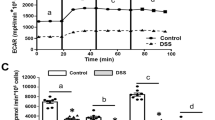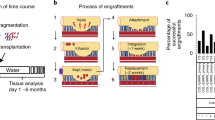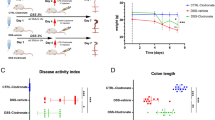Abstract
WHILE we were looking for a suitable preparation to investigate the absorption of amino-acids in the digestive tract, we were impressed by the fact that the potential difference across the epithelium of the small intestine of various species is consistently lower (around 1 mV.) than the potential difference existing across the gastric mucosa or the colon (about 30 mV.). In order to throw some light on this observation we have first measured the flux of sodium across the isolated epithelium of the small intestine and the colon of the turtle Testudo hermanni J. F. Gmelin. We have chosen this species because it is quite easy to strip the muscle layers off the epithelium. The method used is described elsewhere1. Both sides of the isolated epithelium are bathed with saline having the following composition: sodium chloride 113mM ; potassium chloride 1.9 mM; calcium chloride 0.45 mM ; phosphate buffer pH 7.0, 1.5 mM. Table 1 gives the results obtained. It can be seen that there is an active transport of sodium from the mucosal to the serosal side of the preparation in both small intestine and colon. The fact that the values of the short-circuit current are smaller than the values of the net flux means that a cation must be transported actively from the serosal to the mucosal side, or that an anion must be transported actively in the opposite direction. It is also interesting to note that the values of the flux are higher in the small intestine than in the colon and that dinitrophenol inhibits, at least partially, both influx and outflux in the small intestine. This could indicate that part of the outflux of sodium across the small intestine is due to active transport. Let us examine now the effect of a modification in sodium and potassium concentrations on the potential difference across both intestine and colon (Table 2). In these experiments chloride is generally replaced by an equivalent amount of the non-penetrating sulphate anion. Na/10 means a saline containing 10 times less sodium than the physiological saline. Sodium is then replaced by an iso-osmotic amount of sucrose. K × 10 means a saline containing 10 times more potassium than the physiological saline. It can be seen that:
This is a preview of subscription content, access via your institution
Access options
Subscribe to this journal
Receive 51 print issues and online access
$199.00 per year
only $3.90 per issue
Buy this article
- Purchase on SpringerLink
- Instant access to full article PDF
Prices may be subject to local taxes which are calculated during checkout
Similar content being viewed by others
References
Baillien, M., and Schoffeniels, E., Arch. Internat. Physiol. Biochem., 68, 710 (1960).
Schoffeniels, E., Arch. Internat. Physiol. Biochim., 68, 1 (1960).
Author information
Authors and Affiliations
Rights and permissions
About this article
Cite this article
BAILLIEN, M., SCHOFFENIELS, E. Origin of the Potential Difference in the Intestinal Epithelium of the Turtle. Nature 190, 1107–1108 (1961). https://doi.org/10.1038/1901107a0
Issue date:
DOI: https://doi.org/10.1038/1901107a0
This article is cited by
-
Seasonal variation in Na+ transport and (Na+?K+)-ATPase activity in tortoise intestinal epithelium
Journal of Comparative Physiology ? B (1979)
-
Gleichgewichtskonzentrationen einiger Plasma-Solute und Na+-Absorption bei Erh�hung des Na+-Angebotes durch Steigerung der Na+-Angebotskonzentration oder des Perfusionsvolumens/Zeit im Jejunum und Colon von Ratten
Pfl�gers Archiv European Journal of Physiology (1969)
-
Relation of Sodium to the Bioelectric Parameters of Rat Stomach
Nature (1963)



